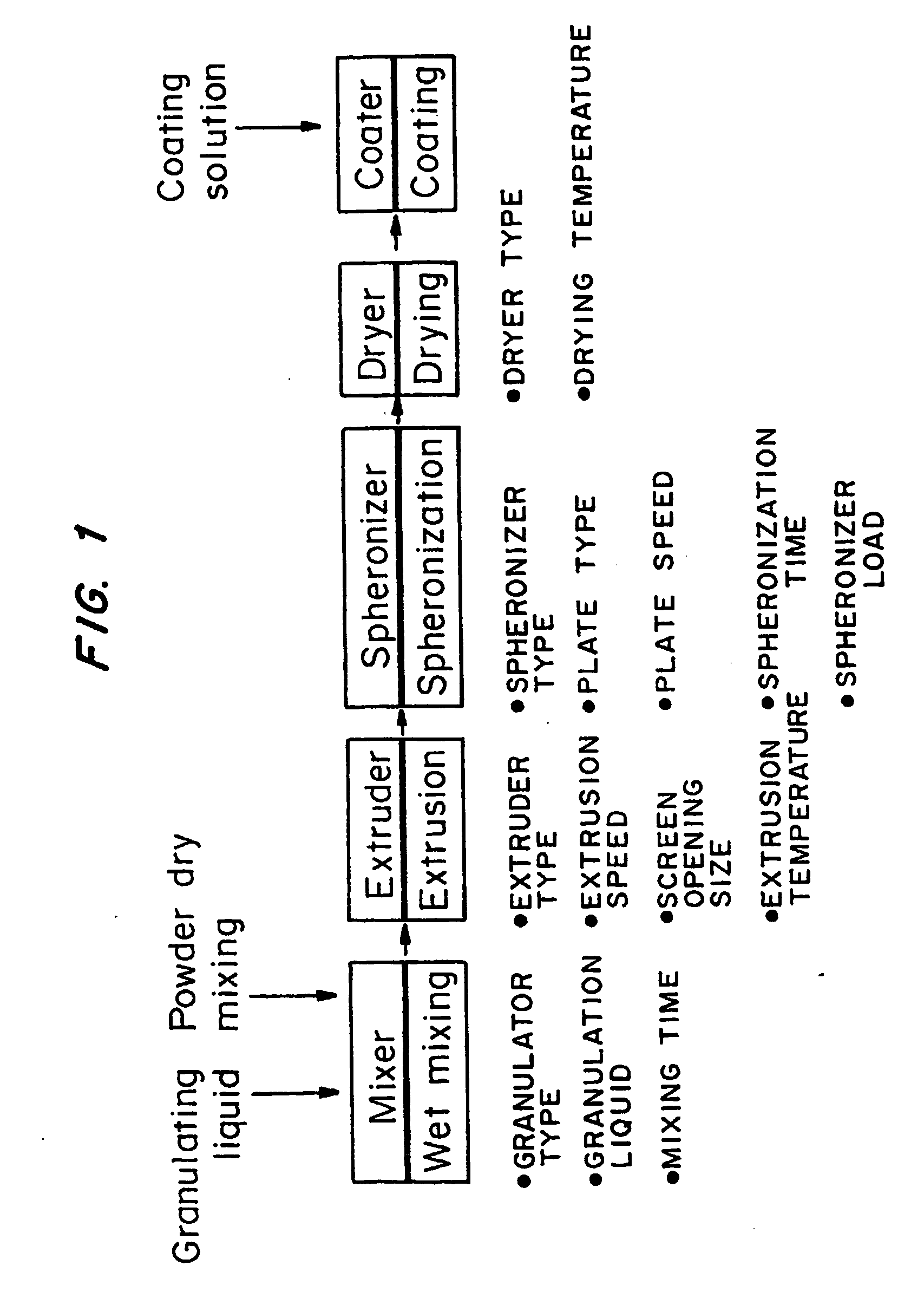Bioadhesive drug delivery system with enhanced gastric retention
a technology of gastric retention and bioadhesive, which is applied in the direction of biocide, antiparasitic agents, drug compositions, etc., can solve the problems of limited particle size and materials, and achieve the effects of increasing gastric retention, prolonging gastric retention time, and increasing gastric retention
- Summary
- Abstract
- Description
- Claims
- Application Information
AI Technical Summary
Benefits of technology
Problems solved by technology
Method used
Image
Examples
example 1
Preparation of Macrospheres for Release of Acyclovir
[0068] Macrospheres with acyclovir in the cores in an amount of 80% and 90% w / w were made using the wet-granulation / extrusion / spheronization process. The overall yield of the process was 90%, and 90% of the spheronized cores were within the size range of 1.4-2.36 mm.
[0069]FIG. 1 is a graph of the granulating and spheronization process used to make the macrospheres. Five unit operations are involved in this process. They are (1) wet granulation (making the dough), (2) extrusion of the granulation or “dough” into cylinders, (3) spheronization of the cylinders into spheres, (4) drying, and (5) film coating.
example 2
Macrospheres with Modified Release
[0070] Release kinetics were obtained from macrospheres with the following compositions: (1) naked drug cores; (2) EUDRAGIT® RL100-coated (diffusion controlling layer) cores and (3) FASA / FAPP / CaO (bioadhesive)-RL100-drug cores. By incorporating drug into the outer bioadhesive coating, nearly first order release kinetics were obtained.
[0071] The ability to tailor and optimize drug release is achieved by encapsulating drug in either the bioadhesive (composition #3) or rate-limiting (compositions #2) coating or combinations of the two. It is also possible to spray pure drug onto the surface of the outer coating to achieve a quick burst of available drug. The latter can be demonstrated by spraying RL 100 as a 5% coating over 40% drug-loaded cores. The drug in the coating is sodium salicylate (“Drug 1”); the drug in the core is acyclovir (ACV) (”Drug 2”).
[0072] This example demonstrates production of a rate-limiting membrane over the 40% ACV cores. EU...
example 3
Production of Macrospheres with Rate-limiting Membrane and Bioadhesive Coating
[0076] Macrospheres containing 30% acyclovir cores were prepared as described in Example 1, with a rate-limiting membrane as described in Example 2, and further coated with a bioadhesive membrane including EUDRAGIT®, calcium oxide, FAPP (anhydride oligomer), and polymer (polyfumaric acid:sebacic acid). The bioadhesive coating is preferably approximately 50 microns in thickness, although coatings can be between 5 and 20 microns, and 5-20% w / w. The bioadhesive coating was applied by fluidized bed coating. Alternatively the coating may be applied by pan coating.
TABLE 2COMPOSITION OF COATING SOLUTIONS1st Coat2nd CoatTotal SolidsTotal SolidsComponentgm% w / wgm% w / wEudragit ® RS 100550NANAP(FA:SA)NANA315FAPPNANA424CaONANA741Magnesium Stearate110NANATalc3.535NANADibutyl Sebacate0.5515Isopropanol7032Dichloromethane2050
[0077] The function of the materials is as follows: Eudragit® RS 100—Rate-Limiting Polymer; P(F...
PUM
| Property | Measurement | Unit |
|---|---|---|
| diameter | aaaaa | aaaaa |
| diameter | aaaaa | aaaaa |
| diameters | aaaaa | aaaaa |
Abstract
Description
Claims
Application Information
 Login to View More
Login to View More - R&D
- Intellectual Property
- Life Sciences
- Materials
- Tech Scout
- Unparalleled Data Quality
- Higher Quality Content
- 60% Fewer Hallucinations
Browse by: Latest US Patents, China's latest patents, Technical Efficacy Thesaurus, Application Domain, Technology Topic, Popular Technical Reports.
© 2025 PatSnap. All rights reserved.Legal|Privacy policy|Modern Slavery Act Transparency Statement|Sitemap|About US| Contact US: help@patsnap.com



